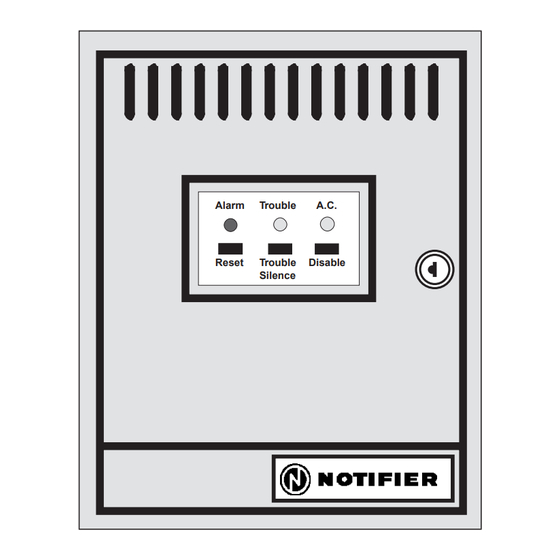
Advertisement
Quick Links
GENERAL
The NOTIFIER CSGL-2000 Fire Alarm Control Panel is
designed in accordance with the following:
National Fire Protection Association (NFPA) Standards
for Protective Signaling Systems: 72A (Local), 72C
(Remote Station).
The compact CSGL-2000 control panel was tested as a
fire protective signaling system control unit under
Underwriters Laboratories Inc., Standard for Safety
number U.L. 864.Underwriter's Laboratories of Canada
(U.L.C.) listed Standard CAN/ULC-S527-M87.
FEATURES
• Discrete component solid-state design.
• Single-zone non-expandable construction.
• Style B (Class B) initiating circuit.
• Built-in surge suppression.
• Built-in brown-out circuitry.
• Single audible Style Y (Class B) circuit rated @ 0.75
amperes.
• Low current drain of panel minimizes battery
amphere-hour requirements.
• Supervision of battery.
• Float charger network.
• Two-wire smoke detector compatible.
• Regulated DC power rated at 100 milliamps.
• Dead-front construction.
• Trouble silence with resound.
• Ground fault circuit.
• Disable switch to silence alarm.
• Power limited for use with limited energy cable.
• In-panel signaling provides:
a. Short pulse = Trouble.
b. Long pulse = Resound.
c. Steady signal = Alarm.
• Trouble circuit monitors the following fault
conditions:
a. Open detector loop(s).
b. Low battery voltage.
c. Missing or disconnected battery.
d. Ground fault.
e. Low AC voltage (brown out).
f. Loss of AC power.
g. "Off Normal" switch position.
h. Open or shorted signaling (bell) circuit.
• Control Switches:
a. "Reset" for control and detectors.
b. "Trouble Silence" with resound.
c. "Disable" to silence alarm.
• LED Indicating Lamps:
a. "A. C." Power
b. "ALARM".
June 1990
CSGL-2000
Fire Alarm Control Panel
c. "TROUBLE".
• Detection Loop:
a. Compatible with many types of two-wire
detectors.
b. Power limited for limited-energy cable.
c. Supervised Style B (Class B) operation.
• Supervised Style Y (Class B) audible/visual
signaling circuit.
• Compact solid state design.
• Automatic float charger.
• Piezo sounder for audible trouble signal.
• Panel will accept one of the following optional
modules:
a. Supplementary alarm contacts, two Form-C.
b. Supplementary alarm and trouble contacts,
Form-C alarm, Form-C trouble (one each).
c. Remote station output, alarm only.
d. Remote station output, alarm and trouble.
APPLICATIONS
The CSGL-2000 Fire Alarm Control Panel is intended
for single zone use in commercial, industrial, and
institutional buildings.
OPERATION
Activation of a compatible two-wire detector or any
normally open fire alarm initiating device will sound
audible signaling devices, illuminate an indicating
LED at the control panel, and operate an optional
module. The optional modules can be used to notify a
remote station, or initiate a supplementary control
function.
20A-42-2
Alarm
Trouble
A.C.
Reset
Trouble
Disable
Silence
Advertisement

Subscribe to Our Youtube Channel
Summary of Contents for Pittway CSGL-2000
- Page 1 National Fire Protection Association (NFPA) Standards for Protective Signaling Systems: 72A (Local), 72C (Remote Station). The compact CSGL-2000 control panel was tested as a fire protective signaling system control unit under Underwriters Laboratories Inc., Standard for Safety Alarm Trouble A.C.
- Page 2 Major Component & Terminal Locations Optional Modules; Choose only one per control panel. MP-AC24 MP-TR24 Transmitter Module Auxiliary Module Transmits Alarm to Two sets of Form-C Responding Authority. alarm contacts. Rated at 3 amperes. MP-AT24 MP-TRT24 Transmitter Module Auxiliary Module Alarm and Trouble Transmits both Alarm and Trouble to...



Need help?
Do you have a question about the CSGL-2000 and is the answer not in the manual?
Questions and answers